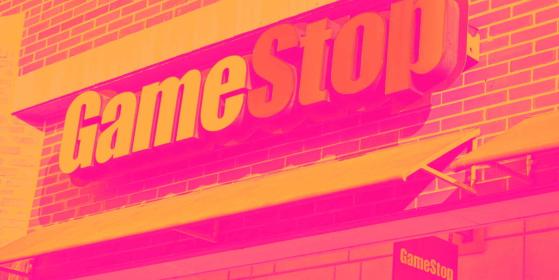Stock Story -
Video game retailer GameStop (NYSE:GME) fell short of analysts' expectations in Q1 CY2024, with revenue down 28.7% year on year to $881.8 million. It made a non-GAAP loss of $0.12 per share, improving from its loss of $0.14 per share in the same quarter last year.
Is now the time to buy GameStop? Find out by reading the original article on StockStory, it's free.
GameStop (GME) Q1 CY2024 Highlights:
- Revenue: $881.8 million vs analyst estimates of $995.3 million (11.4% miss)
- EPS (non-GAAP): -$0.12 vs analyst expectations of -$0.09 (33.3% miss)
- Gross Margin (GAAP): 27.7%, up from 23.2% in the same quarter last year
- Free Cash Flow was -$114.7 million compared to -$111.8 million in the same quarter last year
- Market Capitalization: $16.35 billion
Electronics & Gaming RetailerAfter a long day, some of us want to just watch TV, play video games, listen to music, or scroll through our phones; electronics and gaming retailers sell the technology that makes this possible, plus more. Shoppers can find everything from surround-sound speakers to gaming controllers to home appliances in their stores. Competitive prices and helpful store associates that can talk through topics like the latest technology in gaming and installation keep customers coming back. This is a category that has moved rapidly online over the last few decades, so these electronics and gaming retailers have needed to be nimble and aggressive with their e-commerce and omnichannel investments.
Sales GrowthGameStop is a mid-sized retailer, which sometimes brings disadvantages compared to larger competitors benefiting from better economies of scale. On the other hand, it has an edge over smaller competitors with fewer resources and can still flex high growth rates because it's growing off a smaller base than its larger counterparts.
As you can see below, the company's revenue has declined over the last four years, dropping 9.4% annually as its store count and sales at existing, established stores have both shrunk.
This quarter, GameStop missed Wall Street's estimates and reported a rather uninspiring 28.7% year-on-year revenue decline, generating $881.8 million in revenue. Looking ahead, Wall Street expects revenue to decline 3.7% over the next 12 months.
Same-Store SalesSame-store sales growth is an important metric that tracks demand for a retailer's established brick-and-mortar stores and e-commerce platform.
GameStop's demand has been shrinking over the last eight quarters, and on average, its same-store sales have declined by 5.1% year on year. The company has been reducing its store count as fewer locations sometimes lead to higher same-store sales, but that hasn't been the case here.
Key Takeaways from GameStop's Q1 Results This was an interesting quarter for GameStop. It was initially slated to report earnings on June 11 but pre-announced the results, likely in an attempt to capitalize on the hype generated by Reddit star Roaring Kitty's return. It certainly worked, and the stock is up huge in pre-market trading.
From a fundamental perspective, however, this was a bad quarter for GameStop. Its revenue and EPS missed analysts' expectations, and it didn't share an outlook for the rest of the year. Investors unsurprisingly didn't seem to care, and the stock is up 22.8% after reporting. It currently trades at $57.16 per share, and Roaring Kitty's position is likely now in the upper hundreds of millions of dollars. His call options on the company are rumored to expire on June 21, which will be a big catalyst for its share price.
